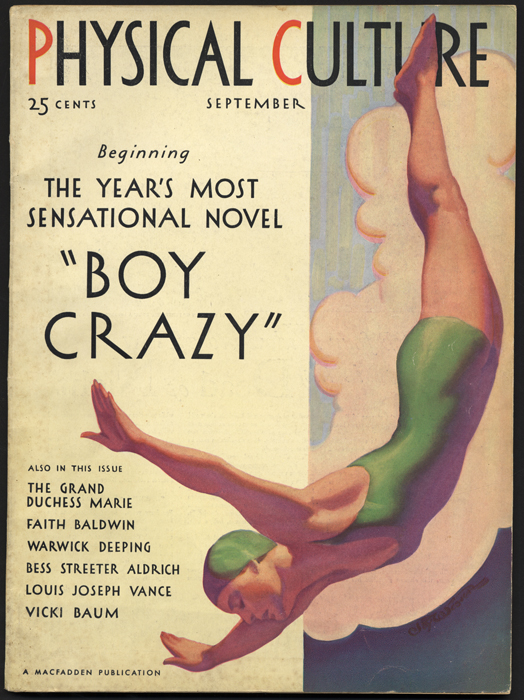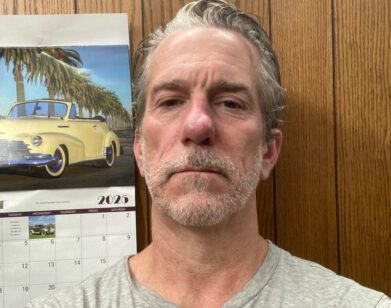A Century in Swimsuits

Sportwear for Sportmen, 1965
Â
If every era gets the swimsuit it deserves, what do string bikinis say about us? Today, Miami design museum The Wolfsonian opens two shows on â??contemporary bathing culture’â??basically, how the swimsuit reflected the social and political experiences of its time.
Fashion design has always shaped current ideas of what was healthy, desirable, glamorous, even hygienic, says Wolfsonian curator Marianne Lamonaca. It’s no coincidence, she notes, that bathing-suit design changed most radically twice in the century: once when women got the vote-and again during the sexual revolution.
The exhibitions, “Beauty on the Beach” and “Sun Stroke Stimulus,” look at just the last 100 years (the latter is contemporary photographs by Miles Ladin), during which time the curators locate four major influences on swimsuit design: the Olympics, new fabrics, Hollywood and public opinion on what was decent. (Coco Chanel and Christian Dior had a voice, too.)
“There’s always been controversy over the revelation of the body in public,” Lamonaca says, explaining thatmodesty ruled swimsuits until almost the 1920s; the bathing costume for women was a dress that included not only stockings, but shoes. Then, everything changed.
In 1919, World War I and its deprivations ended, women got the vote the following year, and Americans crushed competitors in water sports at the 1924 Olympics in Paris. Men’s swimsuit design took a leap forward when U.S. Olympics champions Johnny Weismuller and Duke Kahanamoku endorsed fashionable new lines right after the games. Almost overnight, as their dress hemlines shrunk, women switched to sleeveless tank swimsuits made of wool jersey. (Chanel was showing sleeveless dresses.) Bathing caps topped off the look, covering up the bob haircuts that were all the rage at the time. (LEFT: POSTCARD, 1910)
Â
Jantzenâ??At the Olympic Games, 1929
The new suits were “decried by conservatives saying women shouldn’t be dressed like this,” says the curator. But women shrugged it off, literally. By the early 1930’s “Lastex,” a rubberized synthetic yarn praised as a miracle fabric had been invented, and women were going strapless (the pioneering Jantzen “Shouldaire” was introduced in 1931) to prevent tan lines.
Well into the 20th Century, though, men’s suits were conservative, and included shirts. A popular one in 1932 had “what we call a topper on it… it had a zipper at the waist band so that you could unzip the top,” It was “very fashionable,” says Lamonaca. “There was a big “no-shirt” movement going on in 1936 and by 1937, Atlantic City no longer required men to wear tops on the beach,” she adds.
In 1947, after the severe practical styles of World War II, Christian Dior introduced “The New Look,” a lush, style-conscious line that emphasized a small waist draped in copious amounts of fabric. Swimsuits became similar: rouching at the waist was the style of the day.
The “Beauty on the Beach” show is made up of material from the Wolfsonian’s huge archives and loaned material from swimsuit maker Jantzen, a design pioneer that began adapting men’s woolen crew uniforms into bathing suits circa 1910. Other swimsuit innovators included Cole, Catalina and BVD, which manufactured some of Esther Williams’ costumes. Both Cole and Catalina were based in California, conveniently near Hollywood. Dick Powell, Ginger Rogers, Janet Leigh and Marilyn Monroe all famously modelled swimsuits, and later, films like Where the Boys Are and Elvis Presley’s Clambake, both of which will screen at the Wolfsonian, influenced how stylish or skimpy suits were, says Lamonaca.
Â
The 1950s brought a genuine swimsuit-industry scandal, notes Lamonaca. Catalina had been a longtime sponsor of the Miss American Beauty Pageant, but in 1951, the winner, Yolanda Betbeze, refused to pose for pictures in a suit. (“I’m an opera singer, not a pin-up,” she famously announced. Catalina bolted, founding the rival Miss USA and Miss Universe pageant franchise now owned by Donald Trump. The controversy was covered all over Europe, and juiced the swimwear design industry. Catalina ended up expanding its business internationally and incorporationg more European styling into its suits.
The 1950’s became the era of the constructed, hourglass figure. Bra inserts, boning and tummy panels produced the perfect figure. With airplane travel becoming more routine, prints favored “jet set” designs influenced by the Orient, Polynesia or Latin America. The men’s look was boxier with short swim trunks or swim suits with a matching shirtâ??think Desi Arnaz poolside at the Beverly Hills Hotel.
In the 1960s, young girls rebelled against overly constricted suits. Bikinis were introduced in France in 1946 but didn’t catch on in America until now, as girls sought something that screamed, “This is not your mother’s swimsuit,” says Lamonaca. Bikini bottoms were cut like panties, orhad cutouts at the side held together by plastic rings. (PHYSICAL CULTURE, 1931)
The 1970s were the era of leisurewear on the beach: That meant big floppy straw hats and caftans and Palazzo pants for women; cutoff shorts for men. The decade marked the introduction of the skimpy Brazilian tanga, too. The 1980s fitness craze brought form-fitting suits – hello to the tiny men’s Speedo. And, by the 1990s, “Everybody was making a black suit,” (a color both sophisticated and camouflaging), and there was a boom in engineered prints, constructed to place a particular design element, like a flower, over a specific body part.
So what can we learn abour ourselves? So far, there’s no major design shift or dominant style that marks the first decade of the 21st century, according to Lamonaca. There’s a fashion for retro designs that reflect an increased interest in vintage clothing, and there’s also the popular “skins” that surfers wear. Michael Phelps’ famous Lazer suit was more “technology than fashion,” she says, although it’s been an inspired influence on more standard swimsuit design.
But there may be a change on the horizon. A quick search of the Internet, says Lamonaca, shows that, “All around the world, women are fighting to walk around without their shirts on.” Swimsuit tops are “the last bastion of sexist fashion,” she says. So, what may be next? “Topless.”






